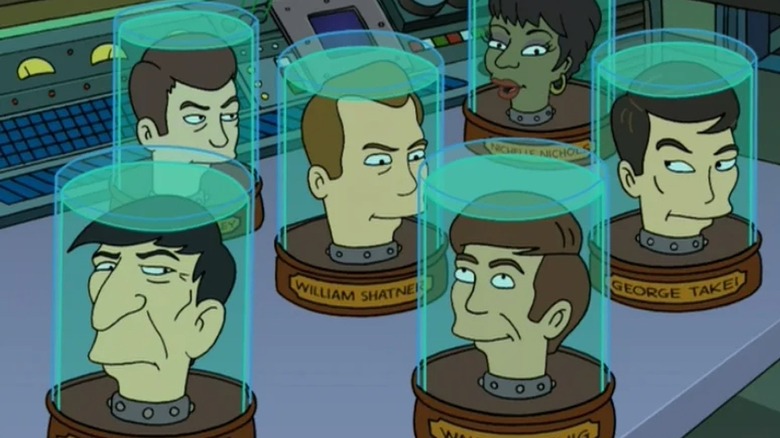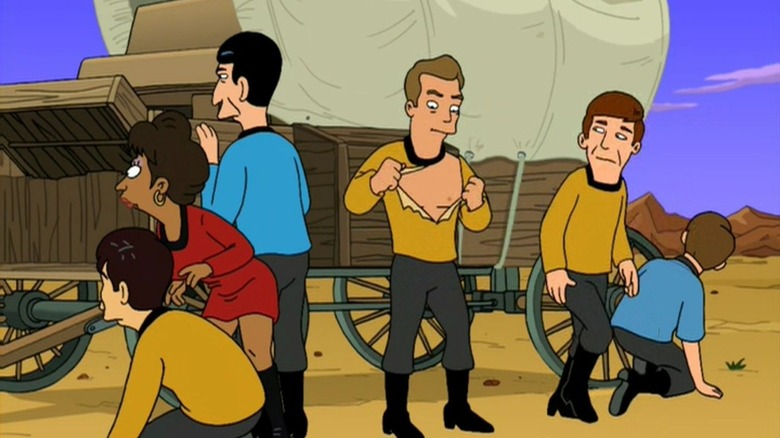Why William Shatner Refused To Guest Star On The Simpsons, But Said Yes To Futurama
In the world of "Futurama," no one is allowed to utter the words "Star Trek" without facing arrest and severe legal penalties. It seems that by the year 3000, Trekkies had gone from being a loose-knit group of geeks to being a full-blown religion. After years of a Trekkie religion, schisms began to form in the church, leading to inevitable and prolonged Holy Wars. To solve the problem once and for all, humanity agreed to load every episode of the original series onto a rocket and launch them into deep space where they would never darken humanity's doorstep again. The severed heads of William Shatner, Nichelle Nichols, Walter Koenig, DeForest Kelley, and George Takei — all of them kept alive in jars — were also loaded onto a rocket and sent into space. Leonard Nimoy's head stayed on Earth and took a job in the local Head Museum. James Doohan's fate was not shared, other than to say he was replaced by a mysterious new character named Welshie.
All this information is revealed in the fourth-season episode "Where No Fan Has Gone Before," wherein Shatner, Koenig, Nichols, Nimoy, and Takei appear as themselves (Kelley had already passed and Doohan refused; Welshie was played by David Herman). Most of these actors had appeared on either "Futurama" or on "The Simpsons," both created by Matt Groening, at least once in the past. Nichols had guested on "Futurama," and Nimoy and Takei had been on "The Simpsons." "Where No Fan" was a first for both Koenig and, curiously enough, for Shatner.
According to the DVD commentary for the "Simpsons" episode "Marge vs. the Monorail," the showrunners revealed Shatner had turned down several "Simpsons" guest spots before.
On Twitter, Shatner himself eventually explained why.
Who the devil are you?
It was "Simpsons" writer Mike Reiss who asked about Shanter's absence from "Marge vs. the Monorail," a logical question, given the presence of his old "Star Trek" co-star Leonard Nimoy. The writers and producers on the commentary track then joshed briefly that Shatner came in and directed Nimoy's scenes (which he most certainly didn't). Producer Al Jean explained that Shatner had been invited onto "The Simpsons" numerous times, going all the way back to the show's first season in 1989, but that he turned them down every time.
It seems that Shatner, for being a notable presence in American popular culture, wasn't so savvy in American pop culture himself. It was more likely he was riding horses on one of his ranches, co-authoring "TekWar" novels, hanging out in his home drinking bottles of Labatt, and appearing at conventions to much notice the phenomenon like "The Simpsons." The animated sitcom was only four years old when "Marge vs. the Monorail" aired, so it was still young and perhaps hadn't yet made its way to Shatner.
"Futurama," meanwhile, was actually explained to him. Shatner's 2020 Tweet explained it plainly: "I didn't know what the Simpson's was and I was told Futurama was a SciFi cartoon."
It seems, then, that when casting agents assumed Shatner's familiarity with "The Simpsons," they misjudged his pop awareness. The casting agents at "Futurama" were humble enough to lay out their show for Shatner, and he was happy to participate. And, golly, was he game. Shatner speak-sang "The Real Slim Shady," and delivered self-deprecating lines of dialogue like "When I directed 'Star Trek V," I got a magnificent performance out of me because I respect me so much."
Between "The Simpsons" and "Futurama," then, we got one pretty fun Shatner performance.

